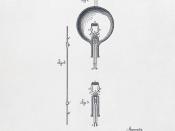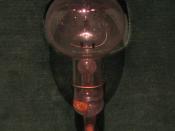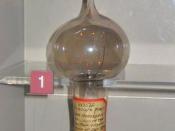Thomas Edison: Inventor of the Future
The Standard of living prior to Thomas Edison's great inventions was of poorer quality. Up to the latter half of the nineteenth century, the machine had always been closely bound to its prime mover (Baldwin 50). It could not be placed too far because of the inefficiency of belts and shafting as a method of distributing energy (Clark 53). Energy and power is everything, it is the key to a working invention. Each gear, joint, or wheel was a source of power loss (Conot 43). Known for his brilliant inventions and ideas, Thomas Edison improved the standard of living at the turn of the twentieth century with such inventions as the electric light bulb and the electric generator.
At the start of the nineteenth century, electricity was a scientific curiosity, a plaything of the laboratory. As the result of widespread investigation and experiment, however, it became a commercially useful form of energy, such as illumination (Jehl 92).
For the first time electricity offered something useful not only in industry, or in commerce, or on the theatre stage, but in every home. Electric lighting would now replace the traditional gaslights that were used (Baldwin 51).
Thomas Edison improved the standard of living during the late 1800s with the electric light bulb (Appendix J). With his ideas and inventions, he helped the American way of life and opened the way to lighting around the world. Edison's invention of lighting using electricity would now begin to phase out the gaslight era. Now that the gaslight era was coming to an end, gas stocks began to tumble. People believed he would now replace gas lighting with electricity (Buranelli 47).
Edison's first announcement that he had a practical filament that had the necessary endurance for long illumination was premature.



Well done
This is a very easy to understand essay that was written very well. I'm definitely citing this one! Keep up the good work :)
0 out of 0 people found this comment useful.